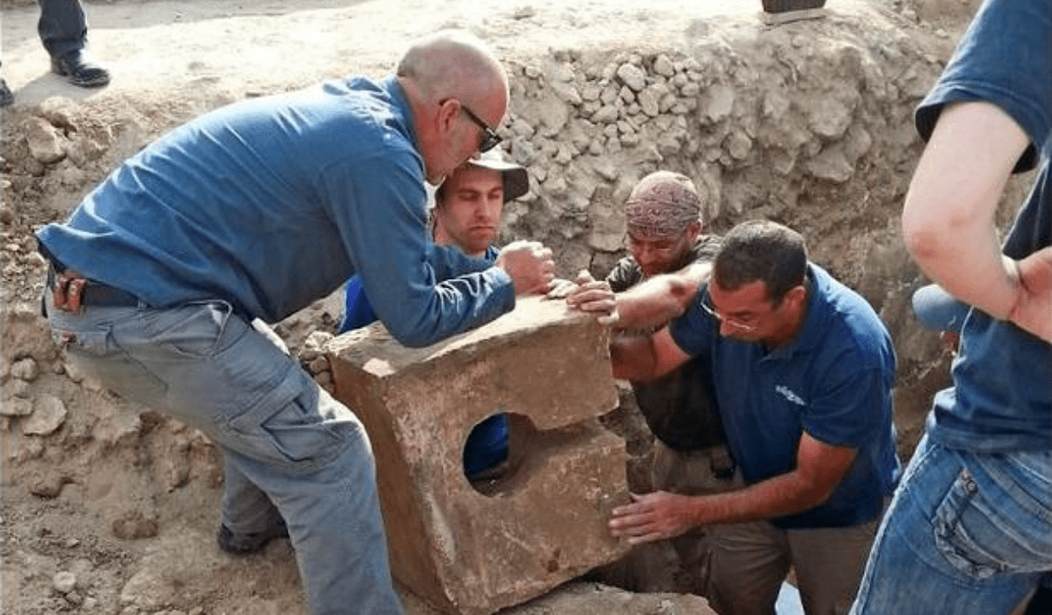An archaeological dig in Israel has unearthed evidence of King Hezekiah’s devotion to Yahweh as recorded in the Bible. The 12th king of Judah, he was the pious son of a godless father, and he launched a war on idolatry, ordering the destruction of all false idols. Archaeologists in the ancient city of Tel Lachish in southern Israel claim to have discovered evidence of that devotion: a shrine dating to the 700s B.C., which shows signs of destruction and desecration around the time of Hezekiah.
Archaeologists with the Israel Antiquities Authority (IAA) discovered a large shrine, and in one of the inner rooms they found two four-horned altars. The horns on the altars appeared to have been intentionally cut, and there was even a toilet discovered in the corner of the shrine!
These discoveries are “probably evidence of the religious reform attributed to King Hezekiah, whereby religious worship was centralized in Jerusalem and the cultic high places that were built outside the capital were destroyed,” excavation director Sa’ar Ganor said in a statement on the find. He quoted 2 Kings 18:4, wherein Hezekiah “removed the high places, smashed the sacred stones and cut down the Asherah poles.”
The IAA archaeologists also discovered a toilet — in the part of the shrine which would have been the holy of holies! The ancient john, a stone fashioned in the shape of a chair with a hole in the center, was found in the corner of the room. Ancient stones like this have been identified as toilets in previous archaeological finds. Biblical evidence that toilets were used to desecrate temples can be found in 2 Kings 10:27: “And they demolished the altar of Baal, and demolished the house of Baal, and made it a latrine to this day.”
Despite evidence of ancient toilets and the biblical passages describing desecration by porta potty, this is the first archaeological find to confirm the phenomenon. The IAA performed lab tests in the spot where the toilet was placed, and the results suggest it was never used. “Hence, we can conclude that the placement of the toilet had been symbolic, after which the holy of holies was sealed until the site was destroyed,” the IAA release read.
The dig was conducted between January and March of this year. The gate discovered at the site is the largest one known in Israel from the First Temple period. “The size of the gate is consistent with the historical and archaeological knowledge we possess, whereby Lachish was a major city and the most important one after Jerusalem,” Ganor explained.
This city gate was more than just a door into Lachish — it contained many rooms with a wide variety of artifacts. Among the artifacts were jars with a special seal impression which the archaeologists connected to the military and administrative preparations of the Kingdom of Judah in the war against Sennacherib, king of Assyria, who attacked in the late eighth century B.C.
Next Page: Why Hezekiah’s war on idolatry was pivotal in the history of Judah.
Sennacherib’s invasion — and his conquest of Tel Lachish in particular — is well known from the archaeological record as well as the Bible. The Assyrian king’s victory over the city in 701 B.C. appears in the wall reliefs in Sennacherib’s palace in Nineveh.
King Hezekiah reigned between 715 and 687 B.C., and his reign is recorded in 2 Kings 18-20, Isaiah 36-39, and 2 Chronicles 29-32. He reigned during the period of Israel’s history known as the “divided kingdom.” After the death of Solomon, son of the famous King David, Solomon’s son Rehoboam alienated ten of the twelve tribes of Israel, who formed their own country, the northern kingdom of Israel under King Jeroboam around 930 B.C. The original kingdom under Rehoboam became known as the southern kingdom of Judah.
Both kingdoms persisted until around 720 B.C., when the Assyrian King Sargon II conquered and subdued Israel. Hezekiah witnessed that defeat, which Bible authors ascribe to the sin and idolatry of the northern kingdom. The books of 1 and 2 Kings and 1 and 2 Chronicles document good and bad kings in both Judah and Israel, and Hezekiah was a pious king who followed his impious father Ahaz.
After Sennacherib conquered Lachish, he besieged the Judaean capital of Jerusalem. The Bible recounts Sennacherib goading Hezekiah, mocking Yahweh and declaring that none of the gods of other countries was able to save their lands from him. Nevertheless, the prophet Isaiah promised that Jerusalem would be saved and Sennacherib would fall.
The Bible records that during the night, an angel of the LORD brought death to 185,000 Assyrian troops. In response, Sennacherib withdrew to Nineveh.
Yahweh saved Hezekiah due to his devotion, so archaeological evidence of that devotion is a wonder to behold.
“The uncovering of these finds joins a long list of discoveries that enlighten us about our historic past, a past that is manifested in our country’s soil and in the writings of the Book of Books,” Israel’s minister of culture and sport, MK (Member of Knesset, the Israeli parliament) Miri Regev, said in the IAA statement.
The Bible — the founding book of the Jewish people, draws the country’s boundaries and the heritage of the Jewish people that was exiled from its country and returned to its homeland. It boldly commemorates the way of our forefathers, the prophets, the kings, and the judges, and the Israeli Antiquities Authority deserves praise for this important discovery, a discovery that deepens our connection to our ancestors who walked this land.
“Before our very eyes these new finds become the biblical verses themselves and speak in their voice,” declared MK Ze’ev Elkin, minister of Jerusalem and heritage and environmental protection. He declared that his ministry works to make sure “as many Israelis as possible will be exposed to the enthralling experience of ancient stones that speak to us of the Bible in their own unique voice.”
This find is indeed significant, and lends further credibility to the biblical narrative of the divided kingdom. Other recent archaeological discoveries have also shed light on this period, especially on King Hezekiah and on texts suggesting the Old Testament is older than previously thought. Another discovery shed light on the Philistines, best known as the people of the giant Goliath.
The discovery at Tel Lachish underscores the biblical theme of God’s faithfulness, as Hezekiah’s loyalty was rewarded with salvation from the Assyrians. Ultimately, Christians look for salvation in Jesus, and Jews still wait for their coming messiah.









Join the conversation as a VIP Member